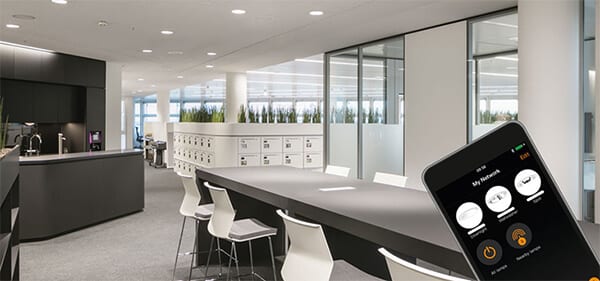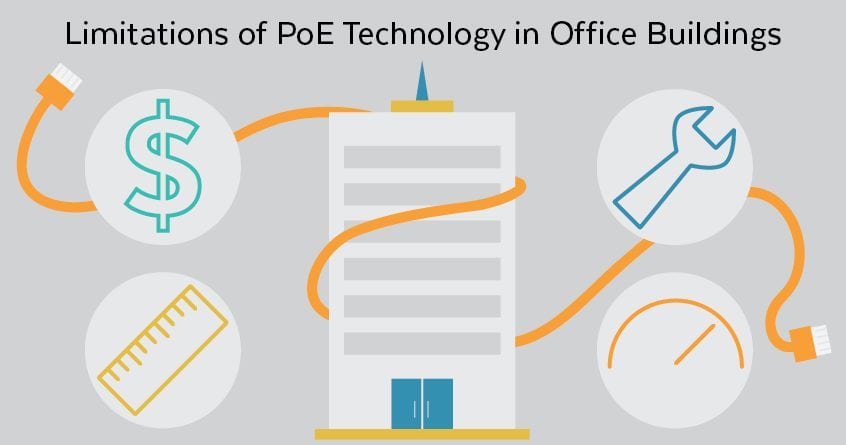As technology for consumers and businesses alike advances, the concept of smart buildings is becoming less science fiction and more science fact.
Nowadays, consumers can already purchase products like smart thermostats, voice-activated lights, and home assistants such as Alexa and Google Home.
Businesses can also benefit from these new innovations. Smart lights and temperature sensors allow for more intelligent environmental control, increasing savings as well as worker comfort.
It is clear that the Internet of Things (IoT) is not going anywhere, and technological integration will only become a larger part of our lives at home and work.
With the rise of smaller electronic devices connecting to the internet, there has become a greater need for power and internet cable networking.
Power over Ethernet fills this role, bringing to the table many advantages over other networking solutions that require two separate cables.
Using just a single cable for power and networking, PoE is more flexible, efficient, and can be more easily installed. In this article, we’ll be taking a look at PoE functions in offices, and specifically the limitations of PoE in offices.
Applications of PoE in Offices
The applications of PoE in offices are only increasing, as technology advances and PoE standards improve. With the advent of PoE Type 4, each PoE port can provide up to 100W, and up to 70W per device. These higher wattages allow for a much wider variety of devices to be connected.
One of the most effective uses for PoE in offices is for lighting purposes. Large networking companies have seen a 50% reduction in installation cost when using PoE-connected lighting systems when compared to traditional AC power systems.
When used in conjunction with LEDs, PoE can be used to install smart lighting systems that can intelligently switch lights on and off when someone enters/exits a room. Additionally, lights can be dimmed and color-shifted to increase worker comfort.

Besides lights, PoE can be used to install sensors to monitor energy consumption, temperature, air quality, or even occupancy sensors. Taking these measures into consideration will improve worker comfort and productivity, as well as reduce energy consideration.
To improve safety, all building entry points could be equipped with RFID sensors for quick and secure entry. Video cameras can also be hooked up to PoE for fast and flexible installation.
Even monitors and laptops can hook up to PoE, thanks to the large wattage increase that PoE Type 4 brings. Video chats in conference rooms could be networked and powered as well. One of the biggest benefits of PoE is its versatility and flexibility.
However, there are still some important limitations regarding PoE utilization in office buildings that should be considered before moving forward.
Installation Costs
While technology like voice control and internet connectivity already exists, it hasn’t yet been implemented everywhere. Not every single building you enter is smart, even though there are a number of benefits to integrating devices onto a single network.
The technology is there, but even though PoE installation is cheaper than traditional set-ups, it’s obviously not free.
Installing a new network from scratch comes with costs associated. While it may not seem too expensive to upgrade your house with a PoE network, it’s important to remember that office buildings are much larger and have many more devices needing connections.
Introducing a PoE network in a large office building is sure to require a multitude of PoE switches, hubs, injectors, splitters, and cables. These will be needed in order to connect to monitors, laptops, sensors, and other networked devices.
Of course, as time goes on, the demand for IoT connected devices will only increase, and offices will need to purchase more devices to stay up to date.
All the associated costs make it somewhat more cost-prohibitive for businesses to upgrade to PoE networks.
Maintenance
Power over Ethernet can be utilized through two different types of switches. The first type is unmanaged switches. These switches are meant to be totally plug-and-play, requiring no set-up to install and use.
Unmanaged switches are cheaper, but they aren’t complex enough to handle the networking needs of an office building. These switches are better suited to consumer purposes, such as smart homes.

The other type of switch is a managed switch. Managed switches are more costly, but provide the additional control that is necessary for a complex office network. IT professionals can expertly adjust managed switches to ensure that every device connected is functioning optimally.
However, this maintenance comes at an additional cost. Employing IT workers to manage PoE switches and hubs is another cost that businesses should be aware of when implementing PoE networks.
Distance and Data Limitations
Besides cost, there other factors to consider when installing a PoE network.
PoE cables have a maximum range of 100 meters, after which the signal drops off very quickly. For consumers, that range should be plenty, but large businesses and buildings may run into problems.
Businesses should take care to place powered devices within a reasonable distance from Power Sourcing Equipment. To combat this, a PoE extender can be used to increase range by an additional 100 meters, although a 200-meter signal might not be sufficient if Power Sourcing Equipment is placed too far away.

Although PoE provides power and data to devices, it is important to make sure quality is not sacrificed in the process. For those looking for heavy network usage, PoE tends to slow the data speed of the network.
This can be avoided by purchasing high-end switches, though.
Conclusion
Overall, PoE is being increasingly utilized to upgrade buildings, homes, and offices, bringing technological integration and the IoT into daily life. In offices alone, there are already a wide variety of uses for PoE, from smart lights to security cameras.
In spite of that, PoE is not without its challenges. Although cheaper than alternatives, it can be costly to implement and maintain. There are also range and data limits to take under consideration when designing a PoE network.

